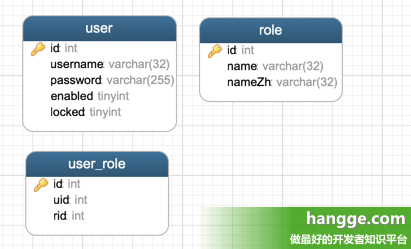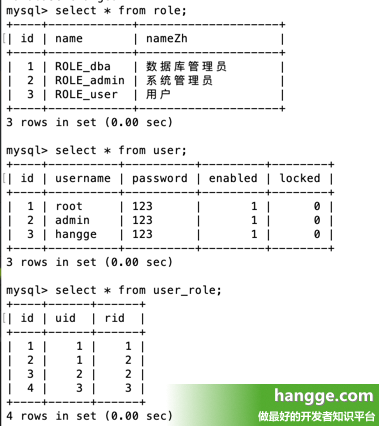之前的文章样例中,认证数据都是定义在内存里。而在真实项目中,用户的基本信息以及角色等都存储在数据库中,因此需要从数据库中获取数据进行认证。本文通过样例进行演示。
三、基于数据库的用户角色配置
1、添加依赖、配置数据库
本次样例使用 MyBatis 来操作数据库,首先在项目中添加 MyBatis 相关依赖,并进行数据库连接配置。
(1)在pom文件添加依赖:
<!-- MyBatis依赖 -->
<dependency>
<groupId>org.mybatis.spring.boot</groupId>
<artifactId>mybatis-spring-boot-starter</artifactId>
<version>1.3.2</version>
</dependency>
<!-- 数据库驱动依赖 -->
<dependency>
<groupId>mysql</groupId>
<artifactId>mysql-connector-java</artifactId>
</dependency>
<!-- 数据库连接池 -->
<dependency>
<groupId>com.alibaba</groupId>
<artifactId>druid</artifactId>
<version>1.1.9</version>
</dependency>
- mybatis-spring-boot-starter:MyBatis 依赖
- mysql-connector-java:MySQL 数据库驱动
- druid:Druid 是阿里巴巴开发的号称为监控而生的数据库连接池,也是目前最好的数据库连接池。
(2)接着在 application.properties 中配置数据库连接信息:
spring.datasource.type=com.alibaba.druid.pool.DruidDataSource
spring.datasource.url=jdbc:mysql://localhost:3306/hangge?serverTimezone=Asia/Shanghai
spring.datasource.username=root
spring.datasource.password=hangge1234
2、创建数据表
(1)首先创建相关的用户角色表,共三张:分别是用户表、角色表以及用户角色关联表。

(2)然后在表中添加一些测试数据。注意:角色名需要有一个默认的前缀“ROLE_”

3、创建实体类
(1)首先创建一个角色表对应的实体类。
@Setter
@Getter
@NoArgsConstructor
public class Role {
private Integer id;
private String name;
private String nameZh;
}
(2)接着创建用户表对应的实体类。用户实体类需要实现 UserDetails 接口,并实现该接口中的 7 个方法:
- getAuthorities():获取当前用户对象所具有的角色信息
- getPassword():获取当前用户对象的密码
- getUsername():获取当前用户对象的用户名
- isAccountNonExpired():当前账户是否未过期
- isAccountNonLocked():当前账户是否未锁定
- isCredentialsNonExpired():当前账户密码是否未过期
- isEnabled():当前账户是否可用
(1)用户根据实际情况设置这 7 个方法的返回值。默认情况下不需要开发者自己进行密码角色等信息的比对,开发者只需要提供相关信息即可,例如:
- getPassword() 方法返回的密码和用户输入的登录密码不匹配,会自动抛出 BadCredentialsException 异常
- isAccountNonLocked() 方法返回了 false,会自动抛出 AccountExpiredException 异常。
- 本案例因为数据库中只有 enabled 和 locked 字段,故账户未过期和密码未过期两个方法都返回 true.
(2)getAuthorities 方法用来获取当前用户所具有的角色信息,本案例中,用户所具有的角色存储在 roles 属性中,因此该方法直接遍历 roles 属性,然后构造 SimpleGrantedAuthority 集合并返回。
@NoArgsConstructor
public class User implements UserDetails {
private Integer id;
private String username;
private String password;
private Boolean enabled;
private Boolean locked;
private List<Role> roles;
@Override
public Collection<? extends GrantedAuthority> getAuthorities() {
List<SimpleGrantedAuthority> authorities = new ArrayList<>();
for (Role role : roles) {
authorities.add(new SimpleGrantedAuthority(role.getName()));
}
return authorities;
}
@Override
public String getPassword() {
return password;
}
@Override
public String getUsername() {
return username;
}
@Override
public boolean isAccountNonExpired() {
return true;
}
@Override
public boolean isAccountNonLocked() {
return !locked;
}
@Override
public boolean isCredentialsNonExpired() {
return true;
}
@Override
public boolean isEnabled() {
return enabled;
}
/** get、set 方法 **/
public Integer getId() {
return id;
}
public void setId(Integer id) {
this.id = id;
}
public void setUsername(String username) {
this.username = username;
}
public void setPassword(String password) {
this.password = password;
}
public void setEnabled(Boolean enabled) {
this.enabled = enabled;
}
public Boolean getLocked() {
return locked;
}
public void setLocked(Boolean locked) {
this.locked = locked;
}
public List<Role> getRoles() {
return roles;
}
public void setRoles(List<Role> roles) {
this.roles = roles;
}
}
4、创建数据库访问层
(1)首先创建 UserMapper 接口:
@Mapper
public interface UserMapper {
User loadUserByUsername(String username);
List<Role> getUserRolesByUid(Integer id);
}
(2)接着在 UserMapper 相同的位置创建 UserMapper.xml 文件,内容如下:
<?xml version="1.0" encoding="UTF-8" ?>
<!DOCTYPE mapper
PUBLIC "-//mybatis.org//DTD Mapper 3.0//EN"
"http://mybatis.org/dtd/mybatis-3-mapper.dtd">
<mapper namespace="com.example.demo.mapper.UserMapper">
<select id="loadUserByUsername" resultType="com.example.demo.bean.User">
select * from user where username=#{username}
</select>
<select id="getUserRolesByUid" resultType="com.example.demo.bean.Role">
select * from role r,user_role ur where r.id=ur.rid and ur.uid=#{id}
</select>
</mapper>
(3)由于在 Maven 工程中,XML 配置文件建议写在 resources 目录下,但上面的 UserMapper.xml 文件写在包下,Maven 在运行时会忽略包下的 XML 文件。因此需要在 pom.xml 文件中重新指明资源文件位置,配置如下:
<build>
<plugins>
<plugin>
<groupId>org.springframework.boot</groupId>
<artifactId>spring-boot-maven-plugin</artifactId>
</plugin>
</plugins>
<!-- 重新指明资源文件位置 -->
<resources>
<resource>
<directory>src/main/java</directory>
<includes>
<include>**/*.xml</include>
</includes>
</resource>
<resource>
<directory>src/main/resources</directory>
</resource>
</resources>
</build>
5、创建 UserService
定义的 UserService 实现 UserDetailsService 接口,并实现该接口中的 loadUserByUsername 方法,该方法将在用户登录时自动调用。
loadUserByUsername 方法的参数就是用户登录时输入的用户名,通过用户名去数据库中查找用户:
- 如果没有查找到用户,就抛出一个账户不存在的异常。
- 如果查找到了用户,就继续查找该用户所具有的角色信息,并将获取到的 user 对象返回,再由系统提供的 DaoAuthenticationProvider 类去比对密码是否正确。
@Service
public class UserService implements UserDetailsService {
@Autowired
UserMapper userMapper;
@Override
public UserDetails loadUserByUsername(String username) throws UsernameNotFoundException {
User user = userMapper.loadUserByUsername(username);
if (user == null) {
throw new UsernameNotFoundException("账户不存在!");
}
user.setRoles(userMapper.getUserRolesByUid(user.getId()));
return user;
}
}
6、配置 Spring Security
Spring Security 大部分配置与前文一样,只不过这次没有配置内存用户,而是将刚刚创建好的 UserService 配置到 AuthenticationManagerBuilder 中。
@Configuration
public class MyWebSecurityConfig extends WebSecurityConfigurerAdapter {
@Autowired
UserService userService;
// 指定密码的加密方式
@SuppressWarnings("deprecation")
@Bean
PasswordEncoder passwordEncoder(){
// 不对密码进行加密
return NoOpPasswordEncoder.getInstance();
}
// 配置用户及其对应的角色
@Override
protected void configure(AuthenticationManagerBuilder auth) throws Exception {
auth.userDetailsService(userService);
}
// 配置 URL 访问权限
@Override
protected void configure(HttpSecurity http) throws Exception {
http.authorizeRequests() // 开启 HttpSecurity 配置
.antMatchers("/admin/**").hasRole("ADMIN") // admin/** 模式URL必须具备ADMIN角色
.antMatchers("/user/**").access("hasAnyRole('ADMIN','USER')") // 该模式需要ADMIN或USER角色
.antMatchers("/db/**").access("hasRole('ADMIN') and hasRole('DBA')") // 需ADMIN和DBA角色
.anyRequest().authenticated() // 用户访问其它URL都必须认证后访问(登录后访问)
.and().formLogin().loginProcessingUrl("/login").permitAll() // 开启表单登录并配置登录接口
.and().csrf().disable(); // 关闭csrf
}
}
7、运行测试
(1)首先在 Conctoller 中添加如下接口进行测试:
@RestController
public class HelloController {
@GetMapping("/admin/hello")
public String admin() {
return "hello admin";
}
@GetMapping("/user/hello")
public String user() {
return "hello user";
}
@GetMapping("/db/hello")
public String db() {
return "hello db";
}
@GetMapping("/hello")
public String hello() {
return "hello";
}
}
(2)接下来测试一下,我们使用 admin 用户进行登录,由于该用户具有 ADMIN 和 USER 这两个角色,所以登录后可以访问 /hello、/admin/hello 以及 /user/hello 这三个接口。

(3)而由于 /db/hello 接口同时需要 ADMIN 和 DBA 角色,因此 admin 用户仍然无法访问。











